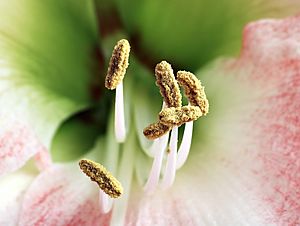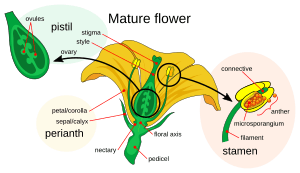Stamen facts for kids

The stamen is like the male part of a flower. Its main job is to make pollen, which is super important for the flower to make seeds and new plants. Think of it as the flower's way of having babies!
Contents
Parts of a Stamen
A stamen has two main parts:
- The anther: This is the top part of the stamen. It's usually a small sac or pouch where the pollen is made and stored.
- The filament: This is like a thin stalk that holds up the anther. It helps to position the anther so that its pollen can easily be picked up by wind or animals.
How Pollen is Made
Inside the anther, there are tiny compartments. These compartments contain special cells called pollen mother cells. These cells go through a process called meiosis, which is a type of cell division that creates new cells with half the usual number of chromosomes.
After this process, the pollen mother cells turn into tiny pollen grains. Each pollen grain holds the male reproductive cells, which are like the "sperm" of the plant. These pollen grains are actually tiny plant structures themselves, ready to help create new life.
The Journey of Pollen (Pollination)
When the pollen grains are ready, the anther opens up to release them. These tiny grains then need to travel from the stamen to another part of a flower called the stigma. This journey can happen in many ways:
- Wind: Some flowers release their pollen into the air, and the wind carries it to other flowers.
- Animals: Many flowers rely on animals like bees, butterflies, birds, or even bats to carry their pollen. When these animals visit a flower to drink nectar, pollen sticks to their bodies and then rubs off on the next flower they visit.
This whole process of pollen moving from the anther to the stigma is called pollination. It's a key step for flowers to make seeds and fruit.
After a pollen grain lands on the stigma, it starts to grow a tiny tube called a pollen tube. This tube grows down into the flower's ovule. The male reproductive cells then travel through this tube to the ovule, where they can join with the female cells to start the process of making a new seed.
Images for kids
See also
 In Spanish: Estambre para niños
In Spanish: Estambre para niños






